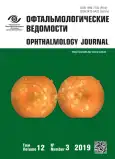Is it possible to cut down the number of unknown etiology in uveitis?
- Authors: Kuznetcova T.I.1, Astakhov Y.S.1
-
Affiliations:
- Pavlov First Saint Petersburg State Medical University
- Issue: Vol 12, No 3 (2019)
- Pages: 21-30
- Section: Original study articles
- URL: https://journals.rcsi.science/ov/article/view/16369
- DOI: https://doi.org/10.17816/OV16369
- ID: 16369
Cite item
Abstract
Background. According to the data in national literature, uveitis comprises 5–15% among all eye diseases. The etiological data on uveitis are still under discussion. Our
aim was to decrease the percent of undefined uveitis.
Methods. The first part was to collect the retrospective data on uveitis etiology (2008–2012). The second one consisted of examining all new patients seen in our uveitis center at the Department of Ophthalmology of the Academician I.P. Pavlov First State Medical University (2014–2016) with up to date methods, like laser photometry, dual angiography and other laboratory and instrumental investigational tests.
Results. The percent of unknown etiology was decreased from 61,9 % to 17 %.
Conclusion. The complex of modern investigational ophthalmological, laboratory and instrumental methods give the opportunity not only to diminish the proportion of undefined uveitis, but also to treat patients with more specific entities.
Keywords
Full Text
##article.viewOnOriginalSite##About the authors
Tatiana I. Kuznetcova
Pavlov First Saint Petersburg State Medical University
Author for correspondence.
Email: brionika@gmail.com
Ophthalmologist, MD, Ophthalmology Department
Russian Federation, 6/8, Lva Tolstogo street, St. Petersburg, 197089Yury S. Astakhov
Pavlov First Saint Petersburg State Medical University
Email: astakhov73@mail.ru
MD, Doctor of Medical Science, Professor, Ophthalmology Department
Russian Federation, 6/8, Lva Tolstogo street, St. Petersburg, 197089References
- Катаргина Л.А., Архипова Л.Т. Увеиты: патогенетическая иммуносупрессивная терапия. Серия Аутоиммунные болезни. – Тверь: Триада, 2004. – С. 10–11. [Katargina LA, Arkhipova LT. Uveity: patogeneticheskaya immunosupressivnaya terapiya. Seriya Autoimmunnyye bolezni; 7. Tver’: Triada; 2004. Р. 10-11. (In Russ.)]
- Панова И.Е., Дроздова Е.А. Увеиты: руководство для врачей. – М.: Мед. информ. агентство, 2014. – С. 9. [Panova IE, Drozdova EA. Uveity: rukovodstvo dlya vrachey Moscow: Medical information Agency; 2014. Р. 9. (In Russ.)]
- Зайцева Н.С., Кацнельсон Л.А. Увеиты. – М.: Медицина, 1984. – 320 с. [Zaitseva NC, Katsnelson LA. Uveitis. Moscow: Medicine; 1984. 320 р. (In Russ.)]
- Tran VT, Auer C, Guex-Crosier Y, et al. Epidemiology of uveitis in Switzerland. Ocul Immunol Inflamm. 1994;2(3):169-176. https://doi.org/10.3109/09273949409057073.
- Foster CS, Vitale AТ. Diagnosis and treatment of uveitis. Vol. 16. W.B. Saunders, Philadelphia, Pa, USA; 2002. P. 21-23.
- Larson T, Nussenblatt RB, Sen HN. Emerging drugs for uveitis. Expert Opin Emerg Drugs. 2011;16(2):309-322. https://doi.org/10. 1517/14728214.2011.537824.
- Rao NA. Uveitis in developing countries. Indian J Ophthalmol. 2013;61(6):253-254. https://doi.org/10.4103/0301-4738.114090.
- Win MZ, Win T, Myint S, et al. Epidemiology of uveitis in a tertiary eye center in Myanmar. Ocul Immunol Inflamm. 2017;25(1): S69-S74. https://doi.org/10.3109/09273948.2015.1133839.
- Al-Dhibi H, Al Shamsi HN, Al-Mahmood AM, Al Taweel HM. Patterns of uveitis in a tertiary care referral Institute in Saudi Arabia. Ocul Immunol Inflamm. 2016;25(3):1-8. https://doi.org/10.3109/09273948.2015.1133836.
- Jones NP. The Manchester Uveitis Clinic: the first 3000 patients –epidemiology and casemix. Ocul Immunol Inflamm. 2015;23(2): 118-126. https://doi.org/10.3109/09273948.2013.855799.
- Nashtaei EM, Soheilian M, Herbort CP, Yaseri M. Patterns of uveitis in the Middle East and Europe. J Ophthalmic Vis Res. 2011;6(4):233-240.
- Foster C.S., Vitale A. Diagnosis and Treatment of Uveitis. 2002. USA. P 22-23
- Устинова Е.И. Туберкулез глаз и сходные с ним заболевания. – СПб.: Левша, 2002. – С. 20. [Ustinova EI. Tuberkulez glaz i skhodnye s nim zabolevaniya. Saint Petersburg: Levsha; 2002. Р. 20. (In Russ.)]
- Арбеньева Н.С., Чехова Т.А., Братко Г.В., Черных В.В. Сравнительный анализ заболеваемости пациентов с увеитами // Сб. науч. работ: Актуальные проблемы офтальмологии: VII Всерос. науч. конф. молодых ученых / Под ред. Б.Э. Малюгина. – М.: Офтальмология, 2012. – С. 28–29. [Arbenyeva NS, Chekhova TA, Bratko GV, Chernykh VV. Comparative analysis of the incidence of patients with uveitis. In: (Collection of scientific articles) Actual problems of ophthalmology: VII Russian scientific conf. of young scientists. Ed. by B.E. Malyugin. Moscow: Ophthalmology; 2012. P. 28-29. (In Russ.)]
- Коновалова Н.А., Пономарева М.Н., Гнатенко Л.Е., и др. Сравнительный анализ динамики заболеваемости пациентов с увеитами // Медицинская наука и образование Урала. – 2015. – Т. 16. – № 1. – С. 92–94. [Konovalova NA, Ponomareva MN, Gnatenko EL, et al. Comparative analysis of dynamics of morbidity of patients with uveitis. Medical science and education of the Urals. 2015;16(1):92-94. (In Russ.)]
- Танковский В.Э., Слепова О.С., Кричевская Г.И. Значение иммунологических методов исследования в диагностике и лечении тяжелых генерализованных увеитов // Сб. науч. трудов научно-практической конференции с международным участием «VIII Российский общенациональный офтальмологический форум»; Москва, сентябрь 22–24, 2015 / Под ред. В.В. Нероева. – М.: Апрель, 2015. – С. 262–265. [Tankovskii VE, Slepova OS, Krichevskaya GI. The importance of immunological research methods in the diagnosis and treatment of severe generalized uveitis. In: (Collection of scientific articles) VIII Russian national ophthalmological forum; Moscow, September 22–24, 2015. Ed. by V.V. Neroyev. Moscow: Aprel’; 2015. Р. 262-265. (In Russ.)]
Supplementary files











